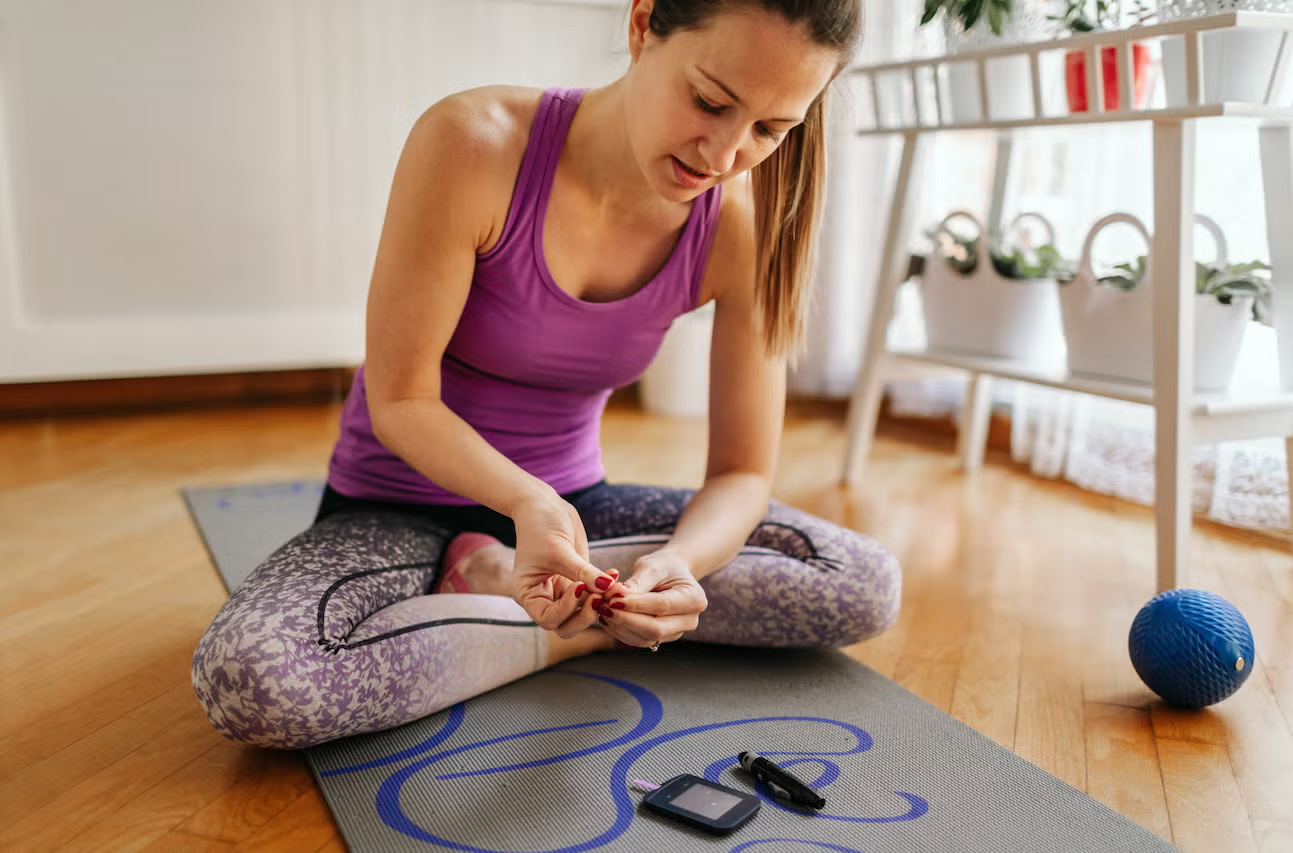Exercise and Diabetes: Which Workouts Are Most Effective?

Exercise and Diabetes: Which Workouts Are Most Effective?
Diabetes is a chronic condition that requires careful management, particularly in terms of controlling blood sugar levels. While medications are often necessary for diabetes management, exercise is one of the most effective ways to help control blood sugar naturally. The role of exercise in managing Type 1, Type 2, and gestational diabetes cannot be overstated; it helps improve insulin sensitivity, supports heart health, and reduces the risk of long-term complications.
But what kinds of exercises are best for people with diabetes?
The good news is that exercise doesn’t have to be intense to produce effective results. A combination of aerobic, strength, and flexibility training has been proven to be beneficial for managing blood sugar levels in a safe and sustainable way.
In this article, we’ll explore the most effective exercises for people with diabetes and how they can help you lead a healthier life. We’ll also provide you with a practical weekly workout plan that can be easily adapted to your lifestyle.

What Is the Best Workout for Diabetics?
The best workout for diabetics should be one that lowers blood sugar, improves insulin sensitivity, and promotes overall heart health. These benefits can be achieved with consistent exercise over time. Thankfully, you don’t have to spend hours in the gym or perform extreme workouts to see significant results. The key is finding an exercise routine that works for you and fits seamlessly into your daily life.
The ideal workout program for someone with diabetes combines aerobic exercise, strength training, and flexibility exercises. Each type of workout offers specific benefits for diabetes management, and when combined, they work synergistically to improve blood sugar levels and enhance overall health.
Best Types of Exercise for Diabetes
When it comes to managing diabetes and improving overall health, exercise is one of the most effective strategies. The right workout plan can help lower blood sugar, improve insulin sensitivity, and boost overall well-being. Below are the most effective types of exercises for diabetes, and how each one helps control your blood sugar:
1. Brisk Walking: A Simple and Effective Choice
Walking is one of the safest and most effective exercises for managing diabetes. You don’t need any special equipment, and you can do it almost anywhere. Whether you’re in the park, around your neighborhood, or even on a treadmill, walking can provide significant benefits for blood sugar control.
How It Helps:
Walking increases the circulation in your body and helps your muscles absorb glucose (sugar) without the need for insulin. This means your body uses blood sugar more efficiently, preventing it from accumulating to unhealthy levels. Regular walking also helps manage weight, which is crucial for those with Type 2 diabetes. Furthermore, it lowers the stress hormone cortisol, which can negatively affect blood sugar levels.
Recommendation:
- Aim for 30 minutes of brisk walking every day.
- Alternatively, take a 10-15 minute walk after each meal to help prevent blood sugar spikes.
- Keep a brisk pace to make sure you’re engaging your body effectively.
Walking can be done at your own pace, but maintaining a brisk pace will give you the best results.
2. Strength Training (2–3 Times Per Week): Build Muscle, Boost Insulin Sensitivity
Strength training, also known as resistance training, involves exercises that build muscle. Building muscle is important for people with diabetes because muscle cells consume glucose at a higher rate than fat cells, helping the body use glucose more efficiently.
How It Helps:
Strength training boosts your metabolism, making it easier to manage weight. Building muscle also enhances insulin sensitivity, which means your body requires less insulin to process blood sugar. Additionally, strength training helps prevent the loss of muscle mass that occurs naturally with age, keeping your body strong and more effective at regulating blood sugar.
Recommendation:
- Try exercises like resistance bands, dumbbells, or bodyweight exercises (such as squats, lunges, and push-ups).
- Perform strength training 2-3 times per week, ensuring that you target major muscle groups in each session.
This form of exercise is especially useful for individuals who want to manage Type 2 diabetes, as it can help improve muscle mass and metabolism over time.
3. Yoga and Stretching: Reduce Stress, Improve Flexibility
Yoga and stretching exercises provide a great way to improve flexibility, joint health, and mental well-being. For people with diabetes, yoga can be particularly effective because it helps manage stress hormones like cortisol, which can raise blood sugar levels.
How It Helps:
Yoga and stretching help relieve tension, improve circulation, and enhance flexibility. Specific yoga poses can even stimulate the organs responsible for regulating blood sugar. Moreover, yoga encourages mindfulness and relaxation, which is essential for reducing stress-related blood sugar spikes.
Recommendation:
- Try poses like child’s pose, cat-cow, seated twists, and legs-up-the-wall.
- Aim for 20-30 minutes of yoga or stretching 2–3 times a week.
- Focus on breathing and relaxation during the session to enhance the stress-relief benefits.
Yoga is ideal for improving both physical and mental health. It’s also excellent for diabetic neuropathy or anyone dealing with stress-related blood sugar fluctuations.
4. Cycling: Low-Impact Cardio for Weight and Sugar Control
Cycling, whether stationary or outdoor, is a low-impact cardio exercise that is gentle on the joints while providing an excellent aerobic workout. Cycling improves heart health and helps burn calories, both of which are vital for people with diabetes.
How It Helps:
Cycling is effective for burning calories and promoting weight loss, two factors that contribute to better blood sugar control. This low-impact exercise is ideal for individuals with joint pain or anyone who wants to avoid overexertion. Regular cycling also improves endurance and helps regulate blood sugar levels by enhancing the body’s ability to use glucose.
Recommendation:
- Cycle for 20–30 minutes at a moderate pace several times a week.
- Gradually increase the intensity and duration as your fitness improves.
Cycling is an excellent exercise choice if you prefer a less stressful workout on the joints and want to burn calories while improving blood sugar levels.
5. Swimming: Full-Body Workout That’s Easy on the Joints
Swimming provides a full-body workout that engages nearly every muscle in the body. It’s especially useful for people with joint issues or diabetic neuropathy because it is a low-impact activity that doesn’t put pressure on the joints.
How It Helps:
Swimming helps improve endurance, balance, and sugar metabolism. Since it’s a whole-body workout, it strengthens the muscles while improving circulation. It also provides a full cardiovascular workout, enhancing heart health without overloading your joints. This makes swimming a great exercise for those with joint pain, arthritis, or neuropathy.
Recommendation:
- Swim for 30 minutes or engage in aquatic exercises 2–3 times a week.
- Swimming is also a fun, refreshing way to get active, especially during warmer months.
Because swimming works all the muscles at once, it’s an ideal exercise for managing diabetes while reducing the risk of complications.
Sample Weekly Workout Plan for Diabetics
Maintaining a consistent exercise routine is key to managing diabetes effectively. Here’s a sample workout plan that includes a combination of walking, strength training, yoga, and cardio exercises.
| Day | Activity |
|---|---|
| Mon | Brisk walk (30 mins) + light strength training |
| Tue | Yoga/stretching (20 mins) |
| Wed | Brisk walk + resistance bands (30 mins) |
| Thu | Rest or gentle walk |
| Fri | Bodyweight strength + walk (20 mins) |
| Sat | Swim, cycle, or dance (fun cardio) |
| Sun | Meditation + short walk |
This plan provides a balanced mix of aerobic exercise, strength training, and flexibility exercises for comprehensive blood sugar control and overall well-being.
Exercise Tips for Diabetics
To ensure safe and effective exercise, keep the following tips in mind:
- Check blood sugar levels before and after exercise to ensure they are within a safe range.
- Keep fast-acting carbs (such as glucose tablets or fruit) nearby in case blood sugar drops too low, particularly if you’re using insulin.
- Stay hydrated by drinking plenty of water before, during, and after exercise.
- Wear proper shoes to avoid foot injuries, especially if you have diabetic neuropathy or other foot-related complications.

Final Takeaway: Consistency is Key
When it comes to managing diabetes, consistency is key. Regular aerobic exercise, strength training, and flexibility exercises can help improve blood sugar control, reduce the risk of complications, and support overall health. The best workout is the one you will do consistently. Whether it’s walking, yoga, cycling, or swimming, the goal is to find an exercise routine that fits your lifestyle and helps you manage your diabetes effectively.
By making exercise a regular part of your daily routine, you can improve insulin sensitivity, boost metabolism, and live a healthier, more active life. Start today, and take control of your diabetes naturally.
Written by:
Dr. Laura Chen, MD, Endocrinologist
Dr. Laura Chen is a board-certified endocrinologist with over 15 years of experience specializing in diabetes management. She has worked extensively with individuals to help them control their diabetes through exercise, medication, and a proper diet.
Reviewed by:
Michael Tan, RD, Registered Dietitian
Michael Tan is a registered dietitian specializing in diabetic meal planning. With over 10 years of experience, he works with individuals to develop nutrition plans that support diabetes management and overall health.
References:
Guarnotta, E. What is the stress hormone cortisol? HelpGuide. https://www.helpguide.org/mental-health/stress/what-is-cortisol
Hu, F. B., Li, T. Y., Colditz, G. A., Willett, W. C., & Manson, J. E. Television watching and other sedentary behaviors in relation to risk of obesity and type 2 diabetes mellitus in women. JAMA, 289 https://jamanetwork.com/journals/jama/fullarticle/196345
Petropoulos, I. N., Javed, S., Azmi, S., Khan, A., Ponirakis, G., & Malik, R. A. Diabetic neuropathy and painful diabetic neuropathy in the Middle East and North Africa (MENA) region: Much work needs to be done. Journal of Taibah University Medical Sciences, https://applications.emro.who.int/imemrf/J_Taibah_Univ_Med_Sci/J_Taibah_Univ_Med_Sci_2016_11_4_284_294.pdf






